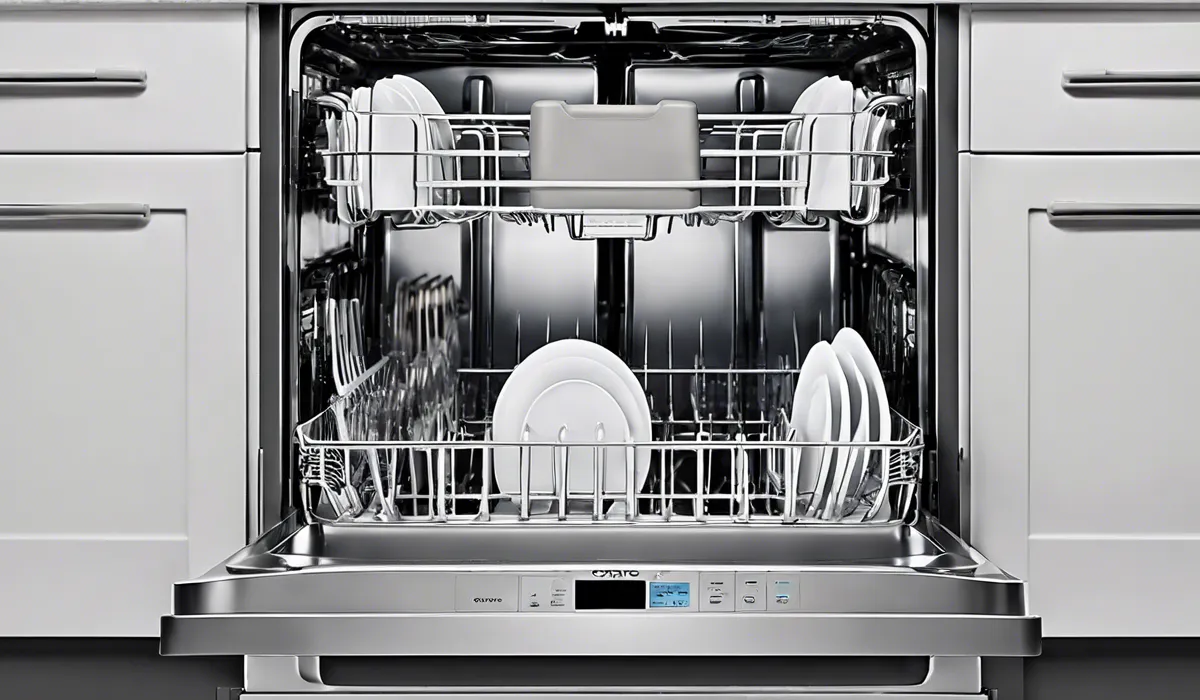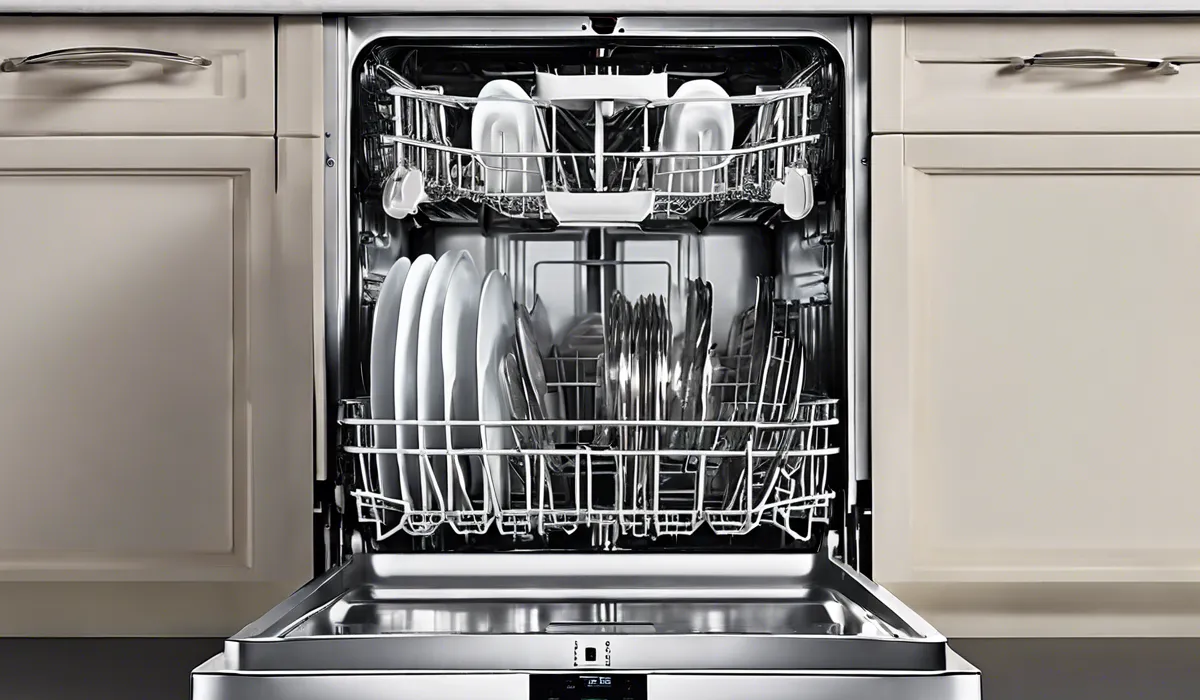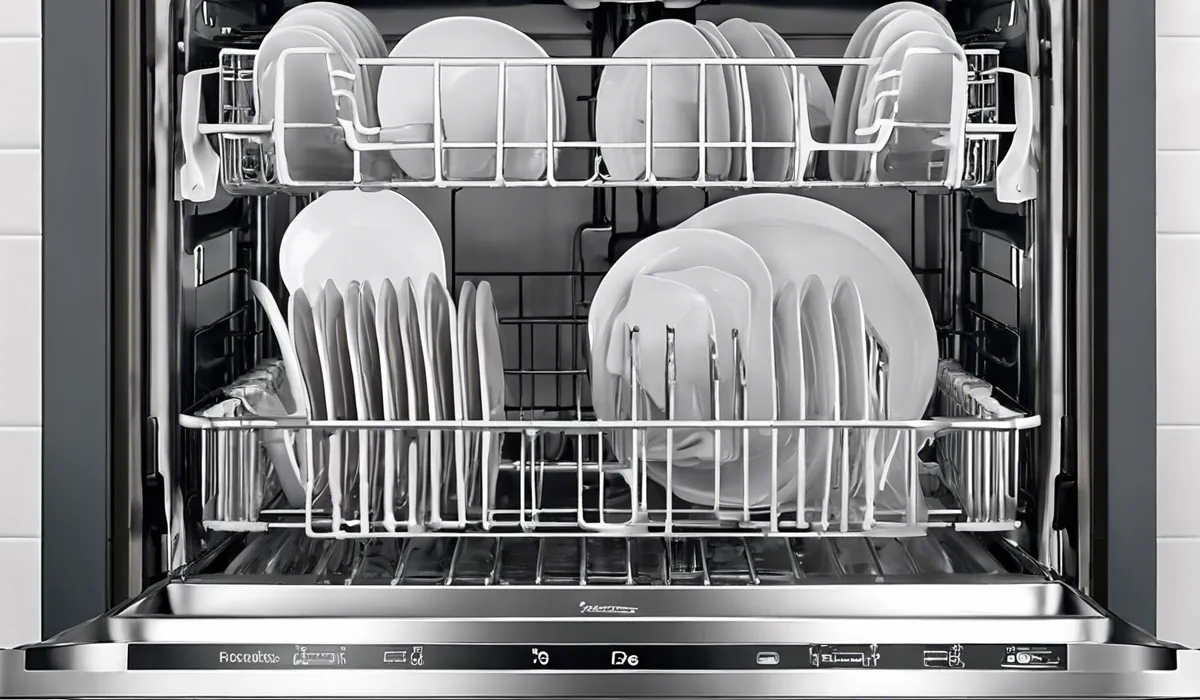Why Dishwasher Top Rack Only? Maximize Clean & Space!
The ‘dishwasher top rack only’ setting is used for small loads, saving energy and water. It’s ideal for delicate items and prevents melting of plastics placed away from the heating element. This cycle is efficient for lightly soiled items or glasses.
Reasons for Using the Top Rack Only in a Dishwasher

Specialized Washing Cycles for Delicate Items
When it comes to caring for delicate items, your dishwasher’s top rack is a sanctuary. Glassware, fine china, and non-dishwasher-safe items often require gentle washing cycles.
The upper rack is strategically placed further from the heating element and uses a softer water spray pattern.
This ensures that your cherished glasses emerge spotless without the hazards of intense heat or forceful water jets that could cause chips or cracks.
Energy and Water Efficiency for Small Loads
Opting for the top rack only setting is not just about caring for fragile items; it’s also a smart move for energy and water conservation. When you have a smaller load, there’s no need to use the full capacity of your dishwasher.
This setting allows you to wash a handful of items without feeling wasteful. It’s an efficient solution for those who may not accumulate enough dishes to warrant a full load, ensuring that every cycle is both economically and environmentally friendly.
As a result, you can enjoy the convenience of a dishwasher without the guilt of unnecessary resource consumption.
Preventing Damage to Large or Heat-Sensitive Items
One of the unsung benefits of the top rack is its protective nature. Large utensils and cookware sometimes don’t fit well in the bottom rack, risking damage during the washing cycle.
Similarly, heat-sensitive items like plastic storage containers are safer in the upper echelon of the dishwasher, away from the heating element’s direct influence.
This strategic placement on the top rack prevents warping and melting, ensuring that your kitchenware remains intact.
How to Properly Load and Use the Top Rack

Sorting Items by Material and Durability
Properly loading the top rack begins with sorting items by their material and durability. Delicate glassware, lightweight plastics, and fragile items should take priority on the top shelf.
This precaution prevents heavier items from causing damage during the cycle. Ensure that you place items at a sufficient distance from each other to avoid contact and potential damage.
The key is to maximize space without compromising the safety of each item. By taking the time to sort and arrange your dishes thoughtfully, you contribute to the overall effectiveness of the cleaning process.
Adjusting the Rack and Sprayer Arms for Optimal Cleaning
Many dishwashers offer adjustable top racks and sprayer arms, allowing you to customize the space for your specific load.
Adjust the height of the rack to accommodate taller items, ensuring they’re not too close to the sprayer arms, which might prevent them from spinning freely.
Additionally, position your dishes so that the water can reach all surfaces. The goal is to allow the sprayer arms to rotate without obstruction, ensuring that water and detergent are evenly distributed for a thorough clean.
Selecting the Appropriate Wash Settings and Detergent
Choosing the right wash settings and detergent is crucial for the top rack only cycle. Since this cycle is designed for delicate items and small loads, it’s important to use a detergent that’s effective yet gentle.
Opt for a liquid or gel that dissolves quickly, avoiding powders that may be too abrasive for your delicate items.
Additionally, select a wash setting that matches the level of soiling. For lightly soiled items, a quick wash may suffice, while a more intensive cycle might be necessary for items with dried-on food.
Maintenance and Care for Dishwasher Top Rack

Regular Cleaning and Inspection of the Rack
To ensure the longevity and performance of your top rack, regular cleaning and inspection are essential.
Over time, food particles and mineral deposits can accumulate on the rack’s surfaces, potentially leading to rust or blockages in the spray arm nozzles.
Gently remove any debris and inspect the rack for signs of wear or damage. Cleaning the rack with a vinegar solution can help dissolve mineral buildup and maintain the rack’s condition.
By keeping the top rack clean, you’ll continue to enjoy its benefits without interruption.
Troubleshooting Common Issues with the Top Rack
Occasionally, you may encounter issues with the top rack, such as dishes remaining dirty after a cycle or the rack becoming difficult to slide in and out. In these instances, first check to ensure that the sprayer arms are not obstructed and are spinning freely.
If the problem persists, inspect the water inlet valve for blockages that may be affecting water pressure. Simple maintenance can often resolve these common issues, keeping your dishwasher running smoothly.
When to Replace the Rack or Contact Professional Service
After years of faithful service, your dishwasher’s top rack may eventually require replacement or professional attention.
If you notice persistent rusting, broken tines, or a malfunction that impedes the rack’s movement, it may be time to consider a replacement.
Similarly, if troubleshooting doesn’t resolve performance issues, contacting a professional service technician can ensure that your dishwasher continues to operate efficiently.
Remember, timely intervention can prevent larger problems and extend the life of your appliance.
FAQs About Dishwasher Top Rack Only
Why should I use the ‘dishwasher top rack only’ setting?
The ‘dishwasher top rack only’ setting is designed for small loads, helping to save energy and water. It’s also ideal for washing delicate items and ensuring plastics don’t melt by keeping them away from the heating element.
Can I use ‘dishwasher top rack only’ for heavily soiled items?
No, the ‘dishwasher top rack only’ setting is not recommended for heavily soiled items. It is best suited for lightly soiled items or glasses.
Is it more energy-efficient to use the ‘dishwasher top rack only’ setting?
Yes, using the ‘dishwasher top rack only’ setting is more energy-efficient as it is designed for smaller loads, requiring less water and energy to run.
Can I place plastics anywhere on the top rack during the ‘dishwasher top rack only’ cycle?
It is generally safe to place plastics on the top rack, but you should keep them away from the heating element to prevent melting.
Is the ‘dishwasher top rack only’ setting quicker than a full load cycle?
It can be quicker since it’s designed for smaller, lightly soiled loads, but the actual time saved varies by dishwasher model and chosen cycle options.
Final Thoughts
The ‘dishwasher top rack only’ setting is an energy and water-efficient option for small, lightly soiled loads. It’s particularly suited for delicate items and ensures that plastics are kept safe from the heating element to prevent melting.
This specialized cycle offers both practicality and economy for everyday dishwashing needs.





